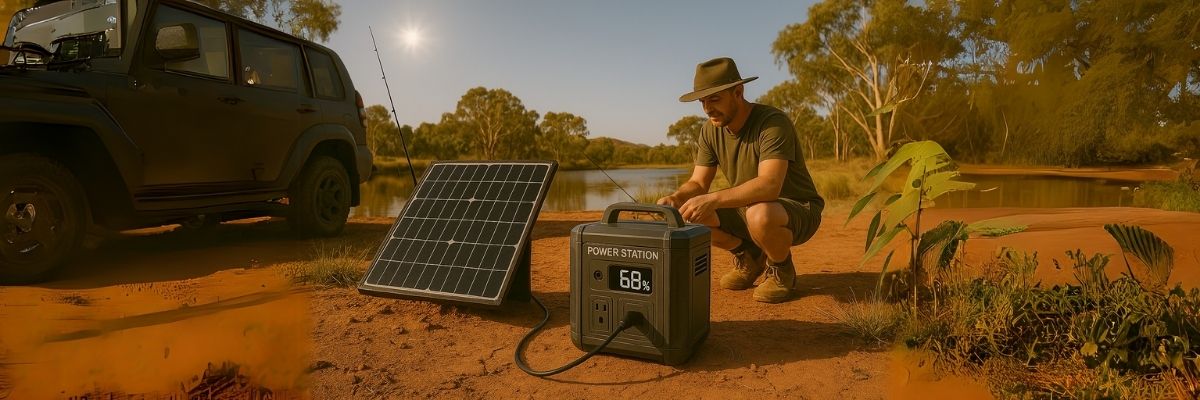
How to Charge a Power Station With a Solar Panel?
If you're out bush, on a fishing trip, or facing a blackout at home, knowing how to charge your Portable Power Station with a solar panel is essential. With the right setup and a bit of sunlight, you can charge sustainably and silently, ensuring your power station is always ready to go when you need it most.
Not sure which power station is right for you?
Take the quiz!
How to Use a Portable Power Station with a Solar Panel
Preparation: What You'll Need
Before you plug in and hope for the best, make sure you’ve got everything sorted. No one wants to be hunting for a missing cable after dark.
Your Portable Power Station
Not all power stations can take a solar feed — but most newer ones do. Have a squiz at your manual or the label near the input ports.
Look out for details like:
- Max voltage and wattage it can handle
- Type of input connector (DC, Anderson, etc.)
If you’ve tossed the manual (we’ve all done it), just check the brand’s website. It'll usually have the specs listed clearly.
Compatible Solar Panels
Here’s where it matters — your solar panel needs to match your power station, or you’ll be waiting all day for a 5% charge.
- Monocrystalline panels are the most efficient and compact.
- Portable/fold-out ones are ideal if you’re packing light.
- Wattage should be close to your power station’s max input, but not over.
Stick with quality panels that are made to work with power stations — not the cheap eBay ones that fry cables after a week in the sun.
Also, check if your panel setup includes a solar charge controller. This device regulates voltage and current from the panels, protecting your power station from damage due to overvoltage or surges. Some portable power stations have a built-in solar charge controller, while others require an external one.

Necessary Cables and Adapters (MC4, Anderson, DC)
This bit often gets forgotten.
You’ll need the right connector to plug your panel into your station. Most setups use:
- MC4 connectors (standard on many panels)
- Anderson plugs (common on bigger units)
- DC barrel jacks (for smaller gear)
Some stations come with adapters, others you’ll need to buy separately. Always check you’ve got the right plug before you head out.
Step-by-Step Charging Process
Unfolding and Positioning Your Solar Panels
Lay your panels out in full sun. Avoid shade — even a gumtree branch or the shadow from your 4WD can knock your input way down.
Tilt them toward the sun if you can. A 20–30° angle usually works well across most of Australia. Some panels have legs or stands — otherwise, prop them up on an esky or camp chair.

Connecting Solar Panels to Each Other
If you’re using more than one panel, you’ll need to decide between:
- Series (adds up voltage — be careful not to go over your power station’s limit)
- Parallel (keeps voltage the same, increases current — safer for most setups)
Use MC4 Y-connectors for parallel. If you’re not sure, go with parallel — less chance of cooking something.
Plugging Solar Panels into the Power Station
Now just plug your panel (or combined output) into the solar input port on your station.
You should see it kick in straight away — maybe a charging symbol, input wattage, or battery percentage going up.
If nothing happens, don’t panic — we’ve got a troubleshooting section below for that.

Monitoring and Troubleshooting Portable Power Station Solar Charging
Checking Charging Efficiency
Charging Indicators and Watts Input
Have a look at the display. You’ll want to see:
- Charging watts (ideally close to the panel’s rating)
- Battery percentage creeping up
- Estimated time remaining
If the numbers look low, move the panel, check for shade, or clean the surface — even a bit of dust can drop efficiency.

Adjusting Panel Angle
The sun moves — and if your panel stays put, it loses efficiency.
If you’re parked up for the day, it’s worth shifting the angle once or twice. Morning, noon, and arvo sun hit differently — and chasing it a bit helps squeeze out more charge.
Troubleshooting Common Issues
Low Input, No Charge, or Error Messages
Problem: You’re in full sun but seeing no watts.
Check: Are all the cables snug? Did the connector come loose? Any shade you missed?
Problem: Charging’s slow or keeps stopping.
Check: Panels overheating? Some stations throttle input if it’s too hot — move it into the shade and try again.
Problem: Error on the screen.
Check: Did you plug in panels with too much voltage? Always stay under the station’s input limit.

If you’re stuck, unplug everything, wait 30 seconds, and reconnect in this order: panels → adapter → station. That usually sorts things.
Solar charging your Portable Power Station is the kind of thing you’ll wonder why you didn’t start doing earlier. It’s quiet, clean, and doesn’t cost a cent once you’re set up.
If you’re not sure which panel matches your gear — or you want something that’ll hold up to the Aussie heat and dust — reach out. We’ll help you get kitted out with something tough, reliable, and ready for whatever trip you’ve got planned.


